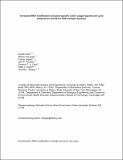Increased tRNA modification and gene-specific codon usage regulate cell cycle progression during the DNA damage response
Author(s)
Patil, Ashish; Dyavaiah, Madhu; Joseph, Fraulin; Rooney, John P.; Chan, Tsz Yan Clement; Dedon, Peter C.; Begley, Thomas J.; ... Show more Show less
Downloadentire manuscript (3.373Mb)
OPEN_ACCESS_POLICY
Open Access Policy
Creative Commons Attribution-Noncommercial-Share Alike
Terms of use
Metadata
Show full item recordAbstract
S-phase and DNA damage promote increased ribonucleotide reductase (RNR) activity. Translation of RNR1 has been linked to the wobble uridine modifying enzyme tRNA methyltransferase 9 (Trm9). We predicted that changes in tRNA modification would translationally regulate RNR1 after DNA damage to promote cell cycle progression. In support, we demonstrate that the Trm9-dependent tRNA modification 5-methoxycarbonylmethyluridine (mcm⁵U) is increased in hydroxyurea (HU)-induced S-phase cells, relative to G₁ and G₂, and that mcm⁵U is one of 16 tRNA modifications whose levels oscillate during the cell cycle. Codon-reporter data matches the mcm⁵U increase to Trm9 and the efficient translation of AGA codons and RNR1. Further, we show that in trm9Δ cells reduced Rnr1 protein levels cause delayed transition into S-phase after damage. Codon re-engineering of RNR1 increased the number of trm9Δ cells that have transitioned into S-phase 1 h after DNA damage and that have increased Rnr1 protein levels, similar to that of wild-type cells expressing native RNR1. Our data supports a model in which codon usage and tRNA modification are regulatory components of the DNA damage response, with both playing vital roles in cell cycle progression.
Date issued
2014-10Department
Massachusetts Institute of Technology. Center for Environmental Health Sciences; Massachusetts Institute of Technology. Department of Biological Engineering; Massachusetts Institute of Technology. Department of ChemistryJournal
Cell Cycle
Publisher
Taylor & Francis
Citation
Patil, Ashish, Madhu Dyavaiah, Fraulin Joseph, John P. Rooney, Clement T.Y. Chan, Peter C. Dedon, and Thomas J. Begley. “Increased tRNA Modification and Gene-Specific Codon Usage Regulate Cell Cycle Progression During the DNA Damage Response.” Cell Cycle 11, no. 19 (October 1, 2012): 3656–3665.
Version: Author's final manuscript
ISSN
1538-4101
1551-4005